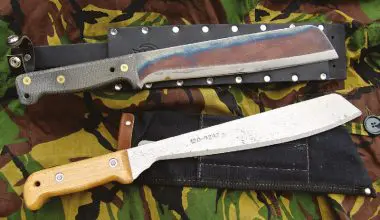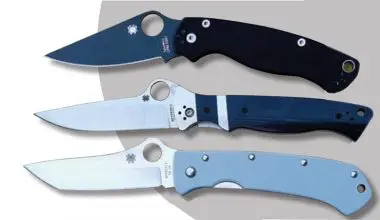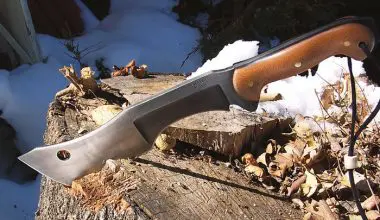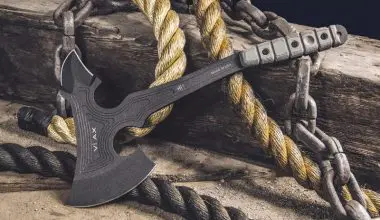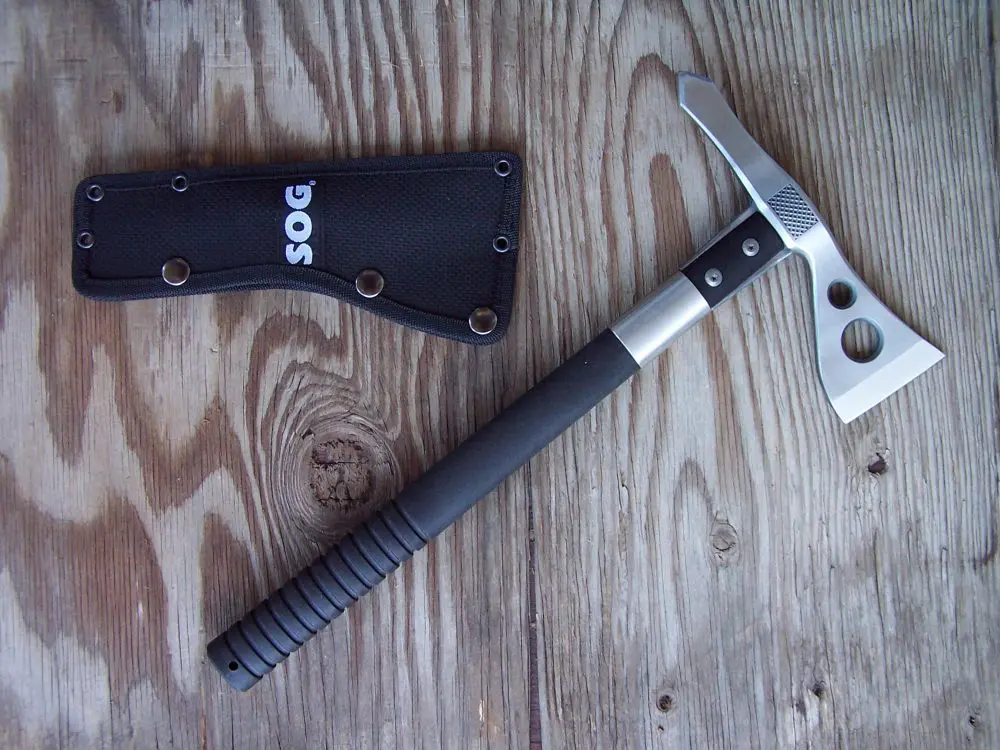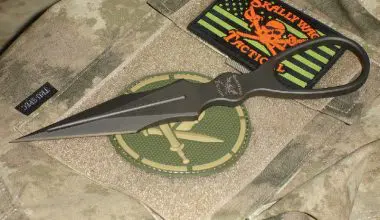I have never lost a knife fight. Because I have never been in a knife fight.
I was issued a nice long hickory billy, not a knife, and a long baton always beat a shorter knife or broken beer stein. But I have cleaned up after some enthusiastic knife vs knife fights, and as a very young man formed an opinion that the only probable way to come out clean in a knife fight is to avoid a knife fight.
It’s funny how those who are spoiling for a knife fight are generally those who have never been in—or even observed— one. Personally, a knife duel would be my least favorite participatory sporting event. Bill Jordan made the succinct observation that in a shooting confrontation there is “no second-place winner.”
While investigating these bloody, usually drunken, knife fights involving GIs with broken beer steins or a big ol’ Solingen blade they’d just bought downtown, one of the first investigative conclusions often was that there was no first-place winner either.
One’s opponent might die first, but odds are good you may still bleed out yourself before receiving medical intervention. S.W.A.T. Editor Denny Hansen remembers a call he got early in his law-enforcement career involving two brothers-in-law in a single-wide trailer who went after each other with steak knives: Neither survived, both bleeding to death and leaving behind an uncommonly grisly crime scene before Hansen reached the scene.
So our first thought here is that speaking softly in a confrontational situation is always worth a try, because “a soft answer turneth away wrath,” and a knife fight that doesn’t happen is a knife fight with two winners.
Our next thought is that, if this best-case scenario is lost and a knife fight is going to happen, the bigger sticker may have a tactical advantage, if all considerations of strength and dexterity are equal. Further, sometimes if an aggressor is still trying to talk himself into a knife fight, the mere introduction of your ten-inch blade may encourage restraint.
Table of Contents
SIZE MATTERS
For the purposes of this consideration, we’ll make a blind assumption that all blade combatants are of equal physiology and skill, and the deciding factor may be the relative reach of the opposing blades. We’ll run with the hypothesis that bigger is better—up to the point it becomes ungainly—and make some comparisons.
A heavy sword obviously has better reach than a knife, but can be cumbersome and not just in a single-wide trailer, but even on an open battlefield. This is why early cut-and-thrust rapiers were developed—it was all about speed and agility. Interestingly, heavy and slow blades never seem to have occurred to Japanese bladesmen in their stylized but very skillful design and use, even though they are masters of the twohanded swing.
If we follow a rock/paper/scissors example, our premise is that a longer blade beats a shorter blade of equal speed, but a faster and shorter blade may trump a longer blade that is heavy enough to be cumbersome. That is, reach is important, but this principle can be beat by a competing blade that is fast enough—and employed skillfully enough—to maneuver inside that reach.
For instance, in a hypothetical contest between a heavy machete and a light Bowie, in equal hands one would expect to see the machete get cut out of the hand that is swinging it.
In skilled hands, choppers such as a machete, kukri or hybrid weapons like the Junglee/Grizzly “short sword” are undoubtedly formidable. Formidable enough at least to make me bolt for the door or dive through a window into the rose bed. However, I think they are probably at the point of diminishing returns on size vs speed, where a good man with a classic Bowie or long tanto might well get inside their slower swing.
A similar parallel might be drawn regarding the tomahawk. A good Hawk can be a formidable weapon, but as Bowie historian and pre-eminent maker Bill Bagwell noted, “Early mountain men chose the tomahawk as a backup weapon to their long rifles. But it was soon replaced by the Bowie knife, which not only served as a good chopping weapon but also was effective for slashing and stabbing, as well as having a backstroke capability. The Bowie was replaced by the revolver as the backup-of-choice.”
How responsive a given blade may be in a particular set of hands will have as much to do with the individual’s makeup as it does with ergonomic design of the particular implement, so we won’t attempt subjective judgments but will just make a straightforward comparison of reach on some of the moderately priced longer blades currently available. Compared side by side, differences stand out.
AND LONGER MAY BE BETTER
In his book Bowies, Big Knives and the Best of Battle Blades, friend Bagwell put it succinctly: A man with a 9½-inch blade can reach and cut a man with a blade 6 or 7 inches long and not get cut himself. That may sound so obvious as to be country simple, but in today’s high-tech thinking it’s a principle that’s often overlooked. It’s so simple people may not realize it….
Let’s run with Bill’s common-sense observation regarding blade length and take a look at several worthy mainstream offerings typically available at a decent price, and consider if length per se is an advantage. Techniques of employing these blades for personal defense—and what your local regulations may have to say about how and where you carry them—are stories for a different campfire.
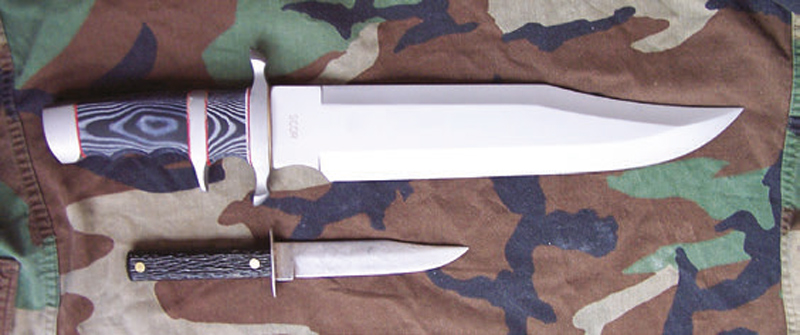
SCHRADE SCOR
Here’s an odd couple that illustrate both the difference in reach and the approach of diminishing returns on size. The massive 12-inch bladed Schrade SCOR Extreme Survival is a big and capable blade for that purpose, but unless you are a framing carpenter, you may not have the arm to swing it briskly, nor for nimble reaction in mid-swing to a moving target. In agile hands, the minimalist 5-inch blade Bowie as sold by Imperial (Schrade) 60 years ago just might get inside with a quick cut.
Taylor Brands | (800) 251-0254 | www.taylorbrandsllc.com
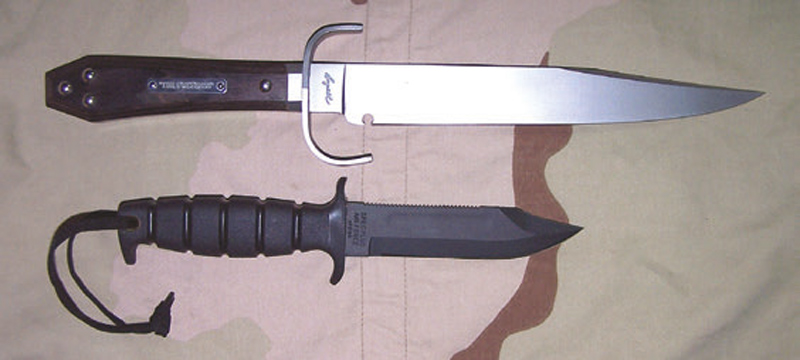 BAGWELL
BAGWELL
Aficionados make a good case for a classic Bowie being the best personal defense blade. Various iterations of the classic pilot bail-out blade such as this Ontario SP-2 are capable and strong for their purpose, but if there were an unavoidable fracas in the offing, I’d probably opt for this Ontario/Bagwell Bowie as my melee weapon.
Ontario Knives | (800) 222-5233 | www.ontarioknife.com
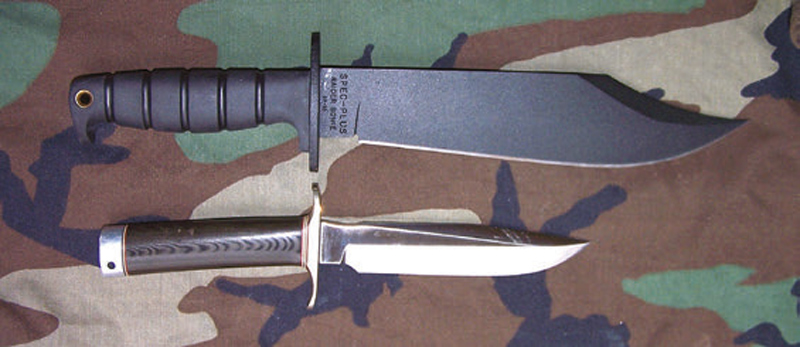 ONTARIO SP10
ONTARIO SP10
Designed and named from the Marine Raider blade of World War II, this configuration proved advantageous enough to be the favored fighting blade among those who could access it. Sharpened, its sweeping clip point was as useful in a backstroke as was the original Bowie, and it has the Bowie’s traditional reach advantage. This modern iteration has a ¼-inch thick blade, as did most early Bowies, and is meatier than the WWII version by Collins. Another pre-eminent design born in WWII was the Randall (bottom), which would never fail, but in this case might come up short.
Ontario Knives | (800) 222-5233 | www.ontarioknife.com
Randall Made Knives | (407) 855-8075 | www.randallknives.com
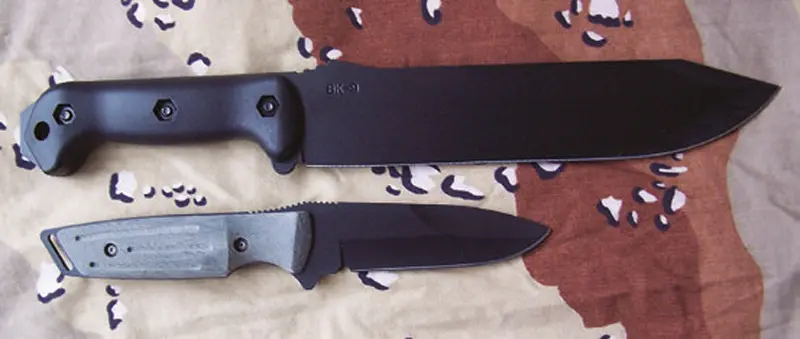 KA-BAR BK-9
KA-BAR BK-9
The “Bowie” moniker has been applied to many fixed-blade knives, and in some advertising circles simply means “not a jack-knife.” The KA-BAR/Becker BK-9 represents a good collaboration, and like all of Ethan Becker’s designs, it works well for its intended purpose. Similar to many early Sheffield Bowies, the blade is deep its full length, with a small clip point. For the discussion at hand, its comfortable nine-inch blade will reach out and touch someone after you pretend to be fishing for your wallet. Like many early Bowies, it hasn’t the cross-guard associated with most later, and modern, models. KA-BAR’s Eagle shown with it is also an excellent blade, but outgunned here.
KA-BAR | (716) 372-5952 | www.kabar.com
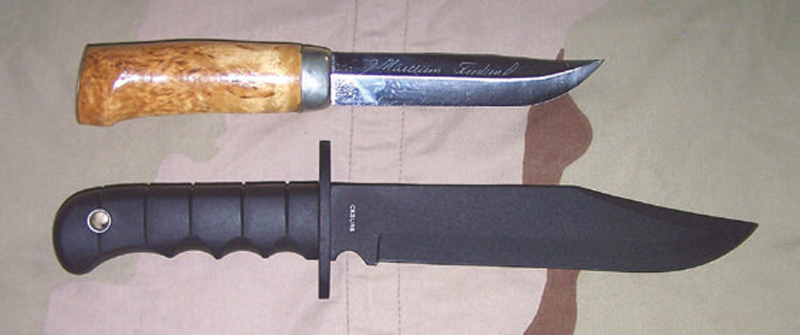 S&W CKSUR6
S&W CKSUR6
S&W Search and Rescue’s 8 5/8-inch blade has a classic Bowie shape but with synthetic coating and ergonomic synthetic handle. It’s of a dimension to readily carry, and easily outreaches the 5½-inch blade Finnish puukko shown with it. Finns succinctly noted they didn’t need a long blade because the average starving Russian soldier was not that thick. That’s true, of course, if you want to stand that close to a man who has been downing raw onions and vodka and also has a knife in his hand.
Taylor Brands | (800) 251-0254 | www.taylorbrandsllc.com
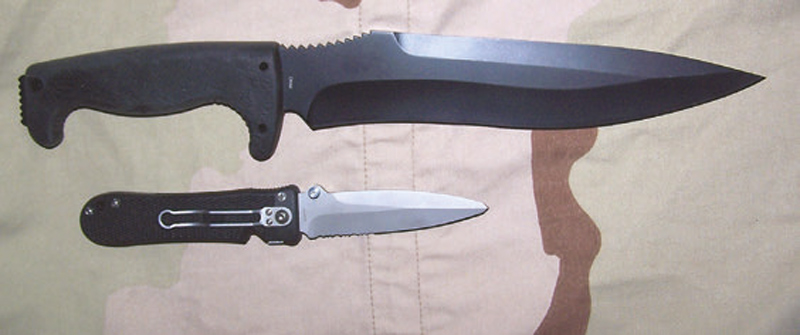 SOG JUNGLE WARRIOR
SOG JUNGLE WARRIOR
SOG’s Pentagon Elite is a good little carry knife, comes spooky sharp and is quick in the hand and discrete. But if somebody pulled one, I don’t know but what I’d rather have their economical and capable 9¾-inch blade Jungle Warrior to respond with.
SOG Knives | (888) 405-6433 | www.sogknives.com
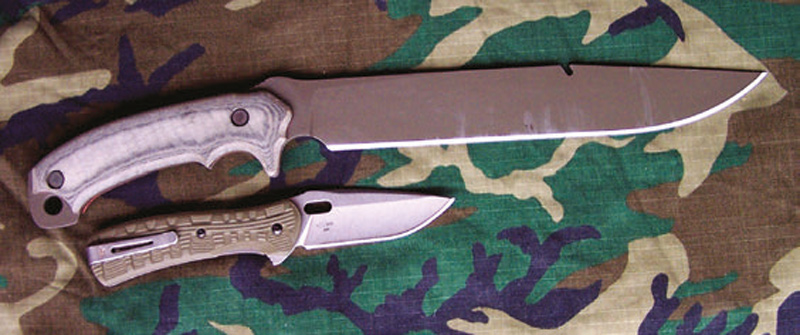
BUCK HOODLUM
Wearing one of Ron Hood’s Hoodlums and a smile just might prevent trouble if somebody forgot their lithium. Buck’s new Vantage Force, successor to their landmark 110 Folding Hunter, is one great folder for any purpose, but it’s overmatched in this comparison.
Buck Knives | (800) 326-2825 | www.buckknives.com
HIGH-ORDER HERESY
IT has been hypothesized that the .30-30 was the most effective deer rifle, because statistically so many deer are harvested with that caliber. Another number that used to be bandied about and skewed for political effect was that crummy little .22 and .32 throw-down revolvers were the most deadly, if you just tallied up the raw numbers of deaths by caliber.
Likewise, if you extracted just the numbers with no situational context, you might conclude that kitchen cutlery, scissors and ice picks make the most deadly blades as weapons. Disingenuous statisticians have actually tried to spin such numbers, of course, which is why some chain restaurants now serve you a politically correct overcooked steak with a butter knife.
The point is not that figures can lie when liars figure. The point here is that even kitchen tools can be effective weapons. Not an optimal weapon, but an effective weapon as long as it has the reach and a keen edge. Heavier cheapo TV chef’s knives lack only cachet, not cutting ability.
A quality defensive blade—or a field blade suitable for defensive use—will be stronger, more ergonomic, have better reach, and retain a keener edge than a yard-sale kitchen knife, of course. These are important points for a field or military knife. But I submit the heresy that used as a weapon of opportunity, edge retention is not that important because knife fights simply do not last that long or involve that many cuts—and historically do not involve severing a free-hanging rope.
Long, fast, and sharp to begin with are the attributes that count.
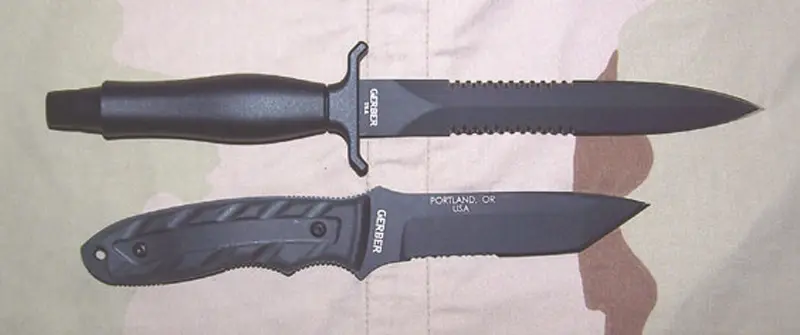 GERBER MK II
GERBER MK II
For its weight, Gerber’s newer 4½-inch Tanto Combat Fixed Blade is an excellent GI utility knife to have with you. But the classic and combat-proven Gerber Mk II in your hand leaves no doubt you intend to defend yourself, and it provides the reach to do so.
Gerber Legendary Blades | (800) 950-6161 | www.gerbergear.com
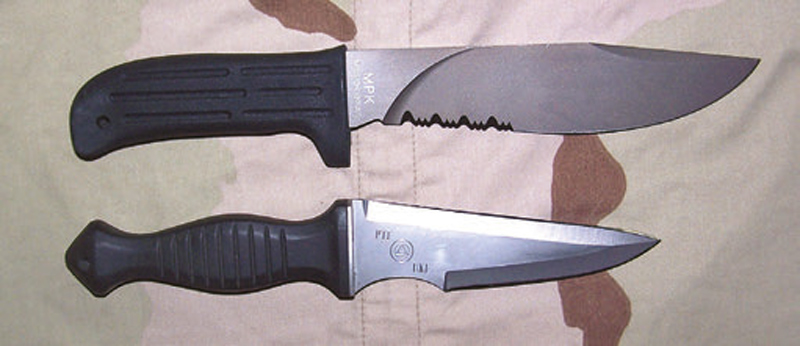 MISSION MPK
MISSION MPK
Given the advantage of reach, a large knife’s point of diminishing return for defense comes with weight and slowness. This Mission MPK-10 7 1/8-inch titanium blade was designed for Navy divers as non-corrosive and non-magnetic, but its strength-to-weight ratio makes it a fast-moving carry blade that weighs only nine ounces. The titanium/steel laminate Tygrys is a dedicated fighting knife and weighs even less, but loses a couple inches of reach.
Mission Knives | www.missionknives.com
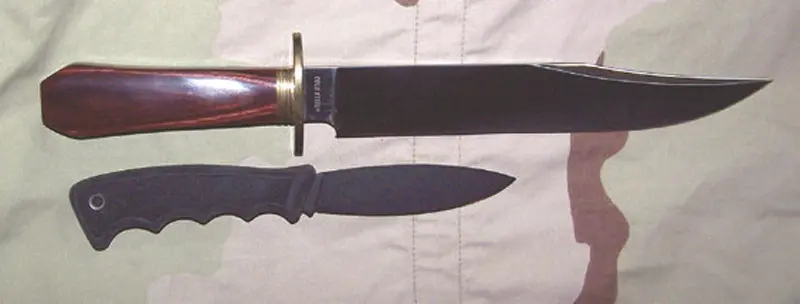 COLD STEEL LAREDO
COLD STEEL LAREDO
True to classic early Bowies, the Cold Steel Laredo is wrought in modern steels with impeccable workmanship, features a modified coffin handle, and retains the lethal length and 4½-inch sharpened clip point and cross-guard of an original. The 10½-inch blade is meaty, in the form most preferred by frontiersmen. Cold Steel’s All-Terrain Hunter is also an excellent and cost-effective field knife, but for serious social purposes, I’d opt for the Laredo.
Cold Steel | (800) 255-4716 | www.coldsteel.com
 JUNGLEE
JUNGLEE
With a blade length of 14½ inches, this Junglee (Grizzly Tools) implement has been marketed as both a machete and a short sword. As a machete, the Seiki-made blade is top tier and one of the most ergonomic machetes I’ve ever swung. When you pick it up, everything starts to look like a blackberry vine, and its matte Teflon coating makes it quiet on impact. But as a short sword—if there’s room to swing a sword—we’d probably opt for a spear. Not that the well-dressed gentleman in Tegucigalpa wouldn’t love this blade, but carrying concealed might be a problem, in addition to speed of deployment.
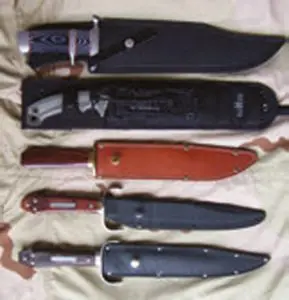 Grizzly Tools | (800) 523-4777 | www.grizzlytools.com
Grizzly Tools | (800) 523-4777 | www.grizzlytools.com
METHODS OF CARRY
How a big blade is carried depends on the implement and the user’s physiology, purpose, dress, and applicable laws. The top two sheaths are classic designs in leather and nylon. There are many options for mounting on or in duty gear. Some can add considerable bulk. The bottom three sheaths are insidethe- waistband types from Cold Steel, River City Sheaths, and Ontario.
